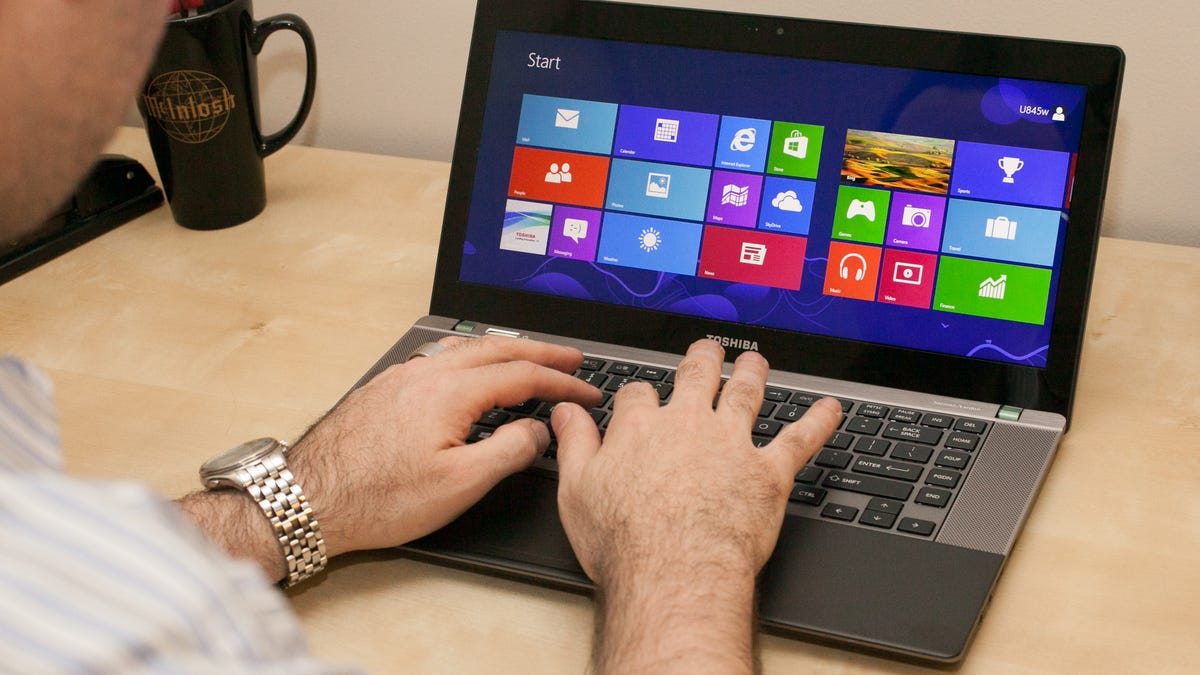My non-touch Windows 8 world
What's it like to live with a Windows 8 laptop that lacks touch? So far, not so great.

Unlike most of my colleagues, my recent Windows 8 experiences have been distinctly nontouch. As it turns out, the only two laptops I've reviewed with Microsoft's new operating system preinstalled both lacked touch screens: the Sony Vaio E17 and the Toshiba Satellite U845W. Both are what you'd consider "classic" laptops -- although the U845W has a unique, extra-wide screen.
Based on these early experiences with two "Windows 8-optimized" laptops, I'm not a fan of the nontouch Windows 8 world.
Escaping 'The Grid'
Honestly, it's hard to be a fan of nontouch on Windows 8, because there are precious few nontouch enhancements to get excited about. The big exciting part of Windows 8 is its tile-grid of touch-friendly apps. It's begging for a tablet, or at least a bendy touch screen, to appreciate. Without either, I feel like I'm missing out on the fun.
But it's more than that. Windows 8 favors touch, and then bends back to accommodate everyone else. Sure, underneath it all is a pretty standard Windows 7-esque desktop environment, but it's not all exactly the same. Certain apps and controls are hard to find, or even begin to know how to find. Some apps don't update perfectly. But Windows 8 pushing this all to the back end feels like the opposite of Mac OS X, which takes all the iOS-like app grids and the Mac App Store itself and pushes it back, out of sight. A Mac starts up like a Mac. A Windows 8 PC starts up like something very different than a Windows 7 PC.
Sure, it just takes a button-press to hop out of "The Grid" (as I like to call it), or you can tweak settings to avoid this interface. But it's an alienating first few hours.
The Importance of touch pads
Bad touch pads get shown up in Windows 8. With all the extra gestures, improved accuracy is a must. And, there's the oddity of off-pad swiping: it brings up Charms and helps find the search bar in Explorer; it switches apps. Many touch pads are recessed, and pulling off an off-edge swipe onto the pad feels uncomfortable -- or worse, the move doesn't register. If you're a new Windows 8 user, you don't need the added confusion of gestures that work sometimes, and don't work other times. It's all a new enough world as it is.
Unfortunately, a lot of Windows laptops have lousy touch pads. It's the rare machine that offers a surface large enough, and smooth-responding enough, to do Windows 8 justice.
Both the Sony Vaio E17 and Toshiba Satellite U845W are fine laptops in terms of battery life, performance, and construction. They just lack stellar touch pads. The E17's is far too small, and the U845W's is large enough but wasn't very responsive. This is common enough in the laptop world, but those touch pads are becoming far more important. I'd also prefer that no Windows 8 touch pad ever be recessed; to pull off the moves requested of you, the user, a flush touch pad with extra room around it is really the way to go.
I could plug in a larger touch pad or use a mouse, but that feels like the laptop equivalent of orthotic shoes. I don't want added gear. I want a normal, fast, fun laptop that doesn't make me want to tear my hair out.
Who needs touch?
Most people don't need a laptop that swivels into a tablet. I'm not even sure I want one. But if I were to buy a Windows 8 laptop, I'd seriously consider it.
You can adjust to Windows 8 without a touch screen. I certainly did. But I don't know if "adjusting" is the best way to experience a new-feel operating system. As more touch-oriented Windows 8 apps get released, I worry that the touchless world will become ever more alienating. And, as I reached up to instinctively paw at the nontouch screen in the hopes of speeding up my Windows 8 experience and help me escape from odd, full-screen, confusingly minimalist apps, I wondered how long I'd want to live with a brand-new Windows 8 PC that lacked touch.
The iPad worked for me because it had no alternatives: touch is its only interface, and I had no other choice. Windows 8 is admirably flexible, but keeping options open will result in some options being better than others. In the NFL, they say having two starting quarterbacks means you have no starting quarterback. I wonder if that's the case here with touch and nontouch.
Of course, this is just my opinion. You may find it fine. In fact, installing Windows 8 on an existing laptop is the most likely path for a lot of people. Nontouch laptops are also more affordable, and less experimental hardware tends to be more reliable. But if I were investing in a Windows 8 computer, I'd find it hard not to heavily consider a touch screen.

